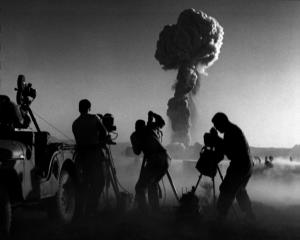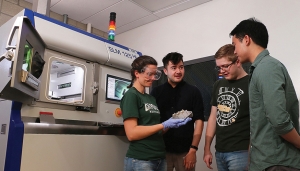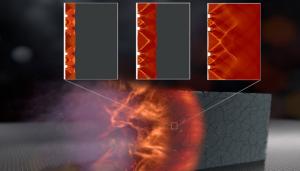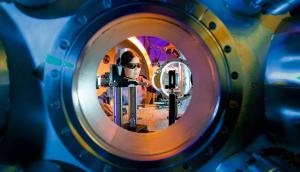LAB REPORT
Science and Technology Making Headlines
June 9, 2017


“Baker," part of Operation Crossroads, a nuclear test by the United States at Bikini Atoll in 1946.
With a boom
Old films of U.S. nuclear weapons tests sat for decades in high-security vaults gathering dust.
But now a crack team of scientists, film experts and software developers from Lawrence Livermore National Laboratory are breathing new life into these fascinating films.
“When you open these cans after being sealed up for 60 years, the first thing you smell is vinegar, and you know that the film is decomposing,” said Greg Spriggs, a weapon physicist at LLNL.
Spriggs, who’s leading the project, says the films are a big part of history. He says the team has been working to locate, scan, reanalyze and declassify the films.

Standing next to the new SLM printer at Cal Poly are (from left) future Lawrence Livermore National Laboratory summer intern Moira Foster, and fellow students Dominique Porcincula, Ben Murray and David Otsu (who is sponsored by the Laboratory for his senior project and master thesis). Photo credit: Dennis Steers/Cal Poly College of Engineering
Students get by with a little help from the Lab
California Polytechnic State University (Cal Poly) San Luis Obispo engineering students now have access to the state-of-the-art in metal additive manufacturing and the ability to perform contracted work for Lawrence Livermore, thanks to a new Selective Laser Melting (SLM) machine on loan to the university.
LLNL purchased the SLM machine and is loaning it to Cal Poly's engineering department, which includes students who have been or will be summer interns at the Lab. Besides being used to conduct research for Lab projects, LLNL hopes to enhance the existing workforce pipeline with the university, the alma mater of many current engineering employees. The school held a celebratory event including the university president and dean of engineering, as well as sponsors and representatives from LLNL, last week.
"The printer has put us on the map at Cal Poly," said Matt Wraith, an LLNL engineering group leader and expert in metal additive manufacturing. "The students and faculty are very interested in it. The machine's primary focus is interacting with students and identifying students that we can hire. From our end, while the build volume is less, the laser is the same, so the product should be the same as what we can build."


Lawrence Livermore and partners have launched the Center for Carbon Removal to develop techniques to transform waste carbon dioxide into valuable products and service.
Wash that carbon right out of the air
How do you create a way to take carbon out of the air and make money doing it?
It’s a problem that is difficult or impossible to solve because of incomplete, contradictory and changing requirements that are often difficult to recognize and will take decades to solve.
The Center for Carbon Removal, in partnership with Lawrence Livermore and Arizona State University and several other research institutions, launched an initiative this week with the goal of developing solutions that transform waste carbon dioxide in the air into valuable products and services.
“Solving a problem with a solution that doesn’t exist” is how Julio Friedmann described it.
“We have urgency around this task,” said Friedmann, LLNL’s chief expert in energy technologies and systems. “I’m seeing windows of opportunity start to close...We’ve got to get the tons (of carbon) out of the atmosphere, and we’ve got to make money doing it.”


An arena test at the Lawrence Livermore National Laboratory’s Site 300 used an aeroshell fashioned from commercial carbon composite panels. This experiment validated warhead performance prior to the sled test.
A weapon like a meteor strike
A “kinetic energy projectile” is a super-dense, super-fast projectile that, operating free of complex systems and volatile chemicals, destroys everything in its path and could operate similar to how a meteor could strike Earth.
In 2013, the U.S. Air Force 846th Test Squadron and civilian researchers at Lawrence Livermore National Laboratory successfully test-fired a kinetic energy projectile, a tungsten-rich shell moving at 3,500 feet-per-second — more than three times faster than the speed of sound — on a specialized track at Holloman Air Force Base in New Mexico.
Explosives may be destructive, but there’s an elegant, almost Newtonian lethality to the kinetic energy projectile, explains Matt Weingart, a weapons program development manager at Lawrence Livermore.
“The classic way of delivering hurt against a target has been to pack a lot of chemical explosive into a container of some kind, a barrel or a cannonball or steel bomb,” Weingart said. “The violence comes from the chemical explosive inside that bomb sending off a blast wave, followed by the fragments of the bomb case. But the difference with kinetic energy projectiles is that the warhead arrives at the target moving very, very fast — the energy is there to propel those fragments without the use of a chemical explosive to accelerate them. The more mass, the more violence.”


By using high-powered arrays of laser diodes and a specialized laser modulator developed for the National Ignition Facility, researchers could potentially 3D print large metal objects in a fraction of the time needed for metal 3D printers on the market today, according to a new study by LLNL researchers. Photo by Kate Hunts/LLNL
Lazing revolutionizes metal 3D printing
A technology originally developed to smooth out and pattern high-powered laser beams for the National Ignition Facility can be used to 3-D print metal objects faster than ever before, according to a new study by Lawrence Livermore researchers.
This new method — Diode-based Additive Manufacturing — uses high-powered arrays of laser diodes, a Q-switched laser and a specialized laser modulator developed for NIF to flash print an entire layer of metal powder at a time, instead of raster scanning with a laser across each layer, as with conventional laser-based powder-bed fusion additive manufacturing systems.
The result, researchers said, is the possibility that large metal objects could be printed in a fraction of the time needed for metal 3-D printers on the market today, expanding possibilities for industries requiring larger metal parts, such as aerospace and automotive.





